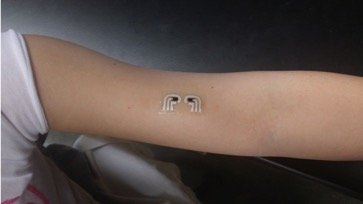A temporary tattoo provides a n!eedle-free solution for measuring blood glucose levels!
Diabetes is one of the most common diseases of our time, affecting hundreds of millions of people, as well as being one of the deadliest. The measurement of blood glucose levels is essential for diabetic patients in order to keep the disease under control and prevent associated problems. But self-measurement of glucose levels requires retrieving a blood sample with a prick of the finger. There has been much research in recent years to develop alternatives to this painful and inconvenient method.
While I was doing research as a visiting scholar with a team led by Prof. Joseph Wang at the Nanoengineering Department of the University of California San Diego (UCSD), we successfully developed a device in the shape of a tattoo for the measurement of blood glucose levels. Published in the journal Analytical Chemistry* the project has produced a paper-based temporary tattoo that applies a weak electrical current to the skin for the measurement.
Developed for epidermal diagnosis, the device brings an enzyme based electrochemical biosensor for detecting glucose together with a method called reverse iontophoresis, which involves applying electrical current to the epidermis, the uppermost layer of the skin, to bring glucose out of the skin.
Biosensors are small devices that make use of biological components such as enzymes, membranes or antibodies for the specific detection of target analytes. This system measures the signal produced by a chemical that is formed as a result of the specific interaction of an enzyme with glucose to detect glucose level.
The initial tests on volunteers proved that the device can reliably measure glucose levels. No differences between measurements with the tattoo and a commercially available glucose monitor were observed. During testing, the volunteers did not experience any negative effects except for a mild feeling of tingling.
The easy to use, flexible, ultra-thin and wearable device is the first of its kind, and promises a step forward for non-invasive glucose testing for diabetic patients.
In the near future, diabetic patients will not have to prick holes in their fingers to measure their blood glucose levels. A tattoo on their arm will successfully do the job.
REFERENCES
- 1. A.J. Bandodkar, W.Jia, C. Yardımcı, X. Wang, J. Ramirez, J. Wang, Anal. Chem., 2015, 87 (1), 394–398.


